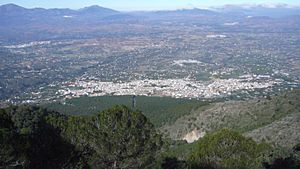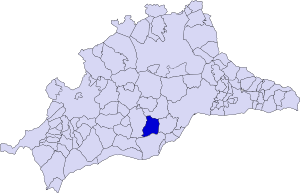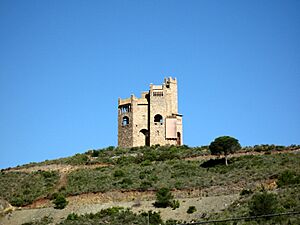Alhaurín el Grande facts for kids
Quick facts for kids
Alhaurín el Grande
|
|||
|---|---|---|---|
 |
|||
|
|||

Municipal location in the Province of Málaga
|
|||
| Sovereign state | |||
| Autonomous community | |||
| Province | |||
| Area | |||
| • Total | 73.1 km2 (28.2 sq mi) | ||
| Elevation | 270 m (890 ft) | ||
| Population
(2018)
|
|||
| • Total | 24,123 | ||
| • Density | 330.00/km2 (854.7/sq mi) | ||
| Time zone | UTC+1 (CET) | ||
| • Summer (DST) | UTC+2 (CEST) | ||
Alhaurín el Grande is a town located in southern Spain. It is found in the province of Málaga within the autonomous community of Andalusia.
The town covers an area of about 73.1 square kilometers. It stretches from the northern side of the Sierra de Mijas mountains to the flat lands of the Guadalhorce river. Here, you can see many farms growing citrus fruits and other fruit trees. In 2010, the town had a population of about 23,675 people.
The name "Alhaurín" comes from the Arabs who lived there long ago. After the Catholic Monarchs took over in 1485, they added "el Grande" (meaning "the Great"). This helped to tell it apart from the nearby town of Alhaurín de la Torre.
Alhaurín el Grande is located between the Fahala river and the Blas González stream. The coast is not far away, and there are good roads to get there. You can reach Málaga Airport and Torremolinos in about 30 minutes by car. A newer road, built in 2010, connects the town to Fuengirola and the beach in just 20 minutes. There is also a road to Marbella to the southwest. From Alhaurín, you can enjoy views over the "Hoya de Málaga", a valley filled with lemon and other fruit trees.
Villafranco del Guadalhorce is a small village that is part of Alhaurín el Grande's area. It was started in the 1950s by families who moved there with help from the Spanish government.
Contents
Discovering Alhaurín el Grande
Geography and Climate
Alhaurín el Grande sits on the northern side of the Sierra de Mijas mountains. It is about 326 meters (1,070 feet) above sea level. The town has a pleasant climate with mild winters and hot summers. More than two-thirds of the year are sunny days! It is about 29 kilometers (18 miles) from Málaga city and 18 kilometers (11 miles) from Marbella.
The people who live in Alhaurín el Grande are called alhaurinos. It is the thirteenth largest city in the Málaga province by population. Only coastal towns, and the cities of Ronda, Antequera, and nearby Alhaurín de la Torre are larger. The town has around 25,000 residents. Many people from other countries also live here, making up about 5% of the total population.
The town includes several neighborhoods like Chorro (or San Antón), el Bajondillo, San Isidro (or Camino de Coin), la Huerta (or el Barrio del Alemán), and la Fama (or the neighborhood of Palustre). There are also housing areas such as La Paca, La Chíchara, El Cigarral, and Sierra Gorda. The small village of Villafranco del Guadalhorce is also part of the municipality.
A Look Back in Time
Alhaurín el Grande has a very long history. People have lived here for thousands of years. Traces of different ancient groups have been found, including Phoenicians, Greeks, Romans, Visigoths, and Arabs.
In the forests southeast of the town, signs of people from the Neolithic Age (New Stone Age) have been discovered. This shows that humans lived in this area a very long time ago.
Later, the Greeks arrived and helped farming grow a lot. They taught people new ways to grow crops, including olive trees and grapevines.
When the Romans came, there was already a small Iberian settlement in the Sierra de Mijas. The Romans named it Lauro Nova. It was a good place to live because the land was fertile, the weather was mild, and the hills had valuable minerals. Roman villas (large country houses) were built around the village. Many Roman remains, like columns, pottery, and coins, have been found. Important sites include Fuente del Sol and Huerta del Niño.
During the time of the Visigoths, the town grew very slowly. But things changed when the Moors took over. They built a fortress on a hilltop called Torres de Fahala. The Moors also gave the town its new name, Alhaurín, which means "Garden of Allah". They linked it to another town with the same name, calling them Alhaurín el Grande and Alhaurín de la Torre. The Romans had called them Lauro Nova and Lauro Vetus.
The fortress was later destroyed during the Reconquista, when Christian kingdoms took back Spain. However, the village itself survived. In the centuries that followed, the town faced challenges like invasions, diseases, and an earthquake in 1680. During the Peninsular War (1808–1814), French troops occupied the town for four years and it was heavily attacked.
Population Changes Over Time

This chart shows how the population of Alhaurín el Grande has changed over many years. You can see how it has grown from 1877 to 2010.
Places to Visit
Alhaurín el Grande has many interesting places to see, showing its rich history and culture:
- Arco árabe del Cobertizo (an old Arab archway from the 12th century)
- Columnas romanas de la Plaza de Ayuntamiento (Roman columns in the town hall square, found nearby)
- Iglesia de Nuestra Señora de la Encarnación (Church of Our Lady of the Incarnation)
- Ermita de San Sebastián (Hermitage of San Sebastián)
- Ermita de la Santa Vera Cruz (Hermitage of the Holy True Cross)
- Ermita del Cristo de las Agonías (Hermitage of Christ of Agonies)
- Ermita de San Antón (Hermitage of San Antón)
- Ruinas de la Fortaleza de Fahala o Castillo de la Reina (Ruins of Fahala Fortress or Queen's Castle)
- Torre vigia de Urique (Urique Watchtower)
- Fuente Lucena o de los Doce Caños (Lucena Fountain or Twelve Spouts)
- Molino de la Paca (Paca Mill)
- Molino morisco de los Corchos y de Maroto o Galiano (Moorish Cork and Maroto or Galiano Mill)
- Porton de San Rafael (San Rafael Gate)
- Casa Consistorial, Cripta del antiguo convento franciscano (Town Hall, Crypt of the old Franciscan convent)
- Casa-Hermandad Museo de la Hermandad de Nuestro Padre Jesús Nazareno (Brotherhood House Museum of Our Father Jesus Nazarene Brotherhood)
- Casa-Hermandad Museo de la Cofradía de la Santa Vera Cruz (Brotherhood House Museum of the Holy True Cross Brotherhood)
- Museo del Pan, El Colmenero de Alhaurín (Bread Museum, The Beekeeping of Alhaurín)
- Biblioteca Municipal "Ildefonso Marzo" (Ildefonso Marzo Municipal Library)
- Teatro Antonio Gala (Antonio Gala Theater)
- Parque La Libertad (Liberty Park)
Getting Around
The main way to travel around Alhaurín el Grande and nearby villages is by bus. The Malaga Metropolitan Transport Consortium runs these buses.
Famous People from Alhaurín el Grande
- Antonio Tejero: A Spanish former military officer known for his role in a historical event in Spain in 1981.
- Gerald Brenan: A British writer and expert on Spain. He lived much of his life in Spain and passed away in Alhaurín el Grande.
See also
 In Spanish: Alhaurín el Grande para niños
In Spanish: Alhaurín el Grande para niños





